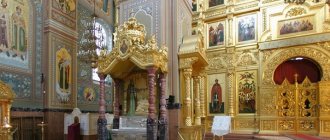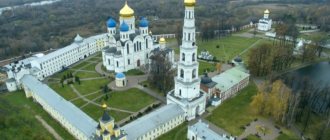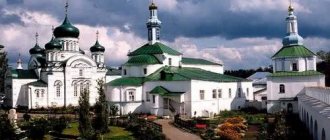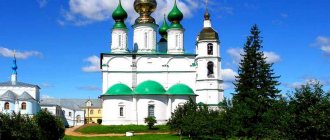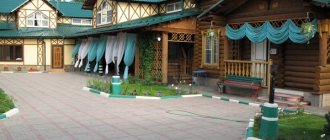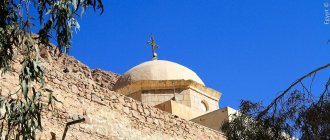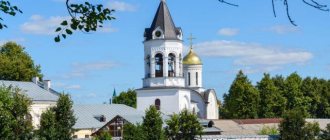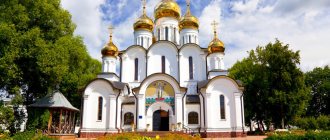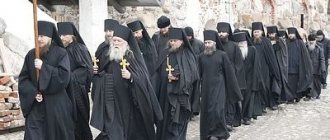For many centuries, the Nikolo-Ugreshsky Monastery has been one of the most favorite places of Orthodox pilgrims. It is located in the small town of Dzerzhinsky near Moscow, Moscow region. The founder of the monastery is considered to be Prince Dmitry Donskoy. Over the years of its existence, the monastery has seen a lot: recognition of kings, various wars and desolation. Now nothing reminds us of difficult times, the monastery has been completely restored and is glad to see within its walls pilgrims who come here from different parts of Russia and abroad.
History of the monastery
According to legend, in 1380, Grand Duke Dmitry Donskoy and his army, on their way to the Kulikovo field, made a halt here, and after a fervent prayer to God, an icon of St. Nicholas the Pleasant miraculously appeared to him on a tree. This miracle greatly strengthened the prince’s faith and gave him a victorious spirit.
The prince said with trepidation: “This whole thing has warmed my heart,” which means: “all this has warmed my heart” (hence the name “Ugreshsky”). And on the way back, after winning the battle, the prince orders a monastery to be built here in honor of this great saint.
In the 17th century, kings and grand dukes loved to come here. These royal pilgrimage trips began to be called “Ugresh campaigns.” The kings from the Romanov dynasty helped the monastery in every possible way. But not everything was always good in the history of the monastery: it was many times subjected to destruction, siege and arson by the Tatar-Mongols, Lithuanian and French armies. But with God's help he always recovered.
The 19th century was a turning point for the monastery: due to high taxes, the monastery was on the verge of closure, with only 6 monks remaining here. During these very years, Metropolitan Philaret of Moscow first thought about appointing Ignatius (Brianchaninov) as rector of the monastery, but he advised him to appoint Hieromonk Ilarius of Optina Hermitage to this position.
Under the leadership of Abbot Ilarius, the monastery is experiencing significant growth. Later, Pimen (Myasnikov), who is now the patron saint of the monastery, becomes the viceroy; under him, it experiences its rebirth: the number of monks increases significantly, the monastery charter becomes more strict, old buildings are revived and new ones are built.
An architectural ensemble is being created, the dominant features of which are the Transfiguration Cathedral and the monastery belfry. The territory of the monastery has expanded significantly, now there are 10 churches and several more chapels.
Drawing. 1. View of the monastery from above
This monastery did not escape the difficult fate of most monasteries in godless times. After the October Revolution, a juvenile colony was located here. The authorities assign monks to the labor community. In the 1920s, all churches in the monastery were closed. In the 30s, all valuables were taken to the Kolomenskoye Museum; in the 40s, the oldest temple of the monastery, St. Nicholas Cathedral, was destroyed.
In the 70s The monastery in Dzerzhinsky began to be restored, but the restoration proceeded slowly. In 1990, worship services were resumed here. And in 1991, the monastery was returned to the church and received stauropegial status. At the end of the 20th and beginning of the 21st centuries, active restoration and restoration of temples and other structures took place here.
Formation in 1380–1600
It is difficult to say exactly what the monastery was like during the years of its foundation. One can only assume, by analogy with other monasteries of that time, that its buildings were wooden. It is now impossible to establish how many temples there were originally. Presumably in the center there was a wooden temple built in honor of St. Nicholas the Wonderworker. The stone temple most likely appeared in the 14th–15th centuries, during the reign of Prince Vasily I, son of Dmitry.
The monastery was a monastery, that is, founded and supported by benefactors. In the 14th–17th centuries, Russian tsars were ktitors of the monastery, and the first, naturally, was Grand Duke Dmitry Donskoy.
In 1519, Prince Vasily III visited here, about which there is an annalistic narrative that is kept in the temple. It is possible that the Moscow princes visited the monastery before , but there is no documentary evidence on this matter.
Monastery now
Now the monastery has about 30 monks, it has been completely restored, and nothing seems to remind us of the difficult atheistic times. In 2004, construction of the Church of the Passion of Christ was completed and a new iconostasis was erected in the Transfiguration Cathedral. St. Nicholas Cathedral was again built according to ancient drawings. In 2009, icon painters completed the interior painting of the Transfiguration Cathedral, made from the original.
Pilgrims can enjoy not only the prayerful atmosphere of the monastery and the decoration of its churches, but also its lovingly landscaped interior, interesting architecture and the monastery pond.
Drawing. 2. Monastery Pond
Interesting! The monastery pond fits perfectly into the ensemble of the monastery. It is not only beautiful, but also rich in various living creatures. Here you can see large fish, two pairs of swans: white and black. In addition, many wild ducks and domestic geese live here, which are bred by the brethren of the monastery. All this multitude of animals walks freely through the green territory of the monastery, without any fear of people.
Also, the pilgrimage service of the monastery has organized a cozy hotel and a refectory where you can eat tasty and inexpensive food. At the moment, the abbot of the monastery is Abbot Bartholomew (Petrov).
Decline in the 18th–19th centuries
Since the 18th century, the monastery has been deprived of numerous benefits and patronage from the kings. The monastery is visited by fewer and fewer pilgrims, and it is gradually falling into decay. According to the archives of the Moscow Consistory, reports were submitted to the Synod about the dilapidation of the monastery churches and requests for help in their restoration, which remained unfulfilled.
Only towards the end of the 18th century did they gradually begin to restore the monastery and build new buildings. In 1771, when there was a plague epidemic in the Moscow lands, an infirmary for the sick was established in the monastery, and the monks were temporarily transferred to the Nikolo-Pervinsk monastery.
Temples and monastery plan
Architectural ensemble of the monastery:
- The oldest building of the monastery is considered to be the bell tower (Ugreshskaya candle) 77 meters high. Which was partially destroyed during the Second World War for strategic military reasons, but in the 20th century it was restored.
- Chapel of the appearance of the image of St. Nicholas the Wonderworker, built in the 19th century. Pilgrims can collect holy water there.
- In the 18th century Sovereign and Patriarchal chambers were built for the kings and patriarchs who came here. They are located next to the monastery belfry and also belong to the antiquities of the monastery.
- Assumption Church (1763). In the 19th century a border was built in honor of the Venerable Mary of Egypt.
- Palestine Wall (1866). The Monk Pimen built it in such a way that its entire appearance would remind one of the temples and buildings in the holy city of Jerusalem.
- At the same time, a monastery monastery was built in honor of the apostles Peter and Paul. It had very strict rules back then. It still works today. The Peter and Paul Church, located in the monastery, is the only building at the monastery made entirely of wood.
- Spaso-Preobrazhensky Cathedral (1880), the construction of which began under St. Pimen and ended in 1894. It is one of the largest churches in Russia. Built in Russian-Byzantine style.
- Cathedral of St. Nicholas the Wonderworker (2006) is a copy of the very first temple.
- Church of the Apostle Matthew and Paraskeva Pyatnitsa (1854).
- Pimenovsky Temple (2002).
- Church of the Icon of the Blessed Virgin Mary “Joy of All Who Sorrow” (1860).
- Church of the Beheading of the Baptist John, which is located in the monastery belfry.
- Temple in honor of the icon of the Mother of God “Seeking the Lost” (2001).
Drawing. 3. Plan - diagram of the monastery
Ugresh Monastery in the 17th–18th centuries
In 1613, Tsar Mikhail Fedorovich ascended the throne. A period of revival and prosperity begins in the life of the Nikolo-Ugreshsky monastery. In the 17th century, the monastery was an impressive architectural complex. According to the inventory, which was made in 1739, the monastery was surrounded by a stone fence and covered with planks. Its length was about 700 meters and its height was three meters. There were two gates.
Three stone churches were built on the territory of the monastery:
- St. Nicholas Cathedral, which was renovated in 1614.
- Church of the Assumption of the Mother of God.
- Church of the Savior Not Made by Hands with a bell tower.
The rest of the temples and buildings were wooden:
- Assumption Church.
- Spassky Church.
In addition to the temples, the monastery had outbuildings:
- Refectory.
- Bread Chamber.
- Patriarchal, fraternal and hospital cells.
- Hotel to accommodate royalty.
- Sovereign's chambers.
Shrines of the monastery
The monastery contains shrines revered by the Orthodox:
- Tikhvin Icon of the Mother of God, prayer image of Patriarch Alexy II, donated to the monastery.
- The relics of the Great Martyr Barbara, the Great Martyr Panteleimon the Healer, John the Baptist, the Kiev-Pechersk saints and many more saints.
- Relics of St. Nicholas the Wonderworker.
- Relics of the Venerable Pimen of Ugresh.
- A copy of the icon of St. Nicholas the Pleasant, painted in the 19th century, who appeared to Prince Dmitry. The original is now kept in the Tretyakov Gallery.
- Ark with the relics of St. Ignatius (Brianchaninov).
- Reliquary cross of the 7th century.
Drawing. 4. Reliquary with the relics of St. Pimen in the Transfiguration Cathedral
Time of Troubles
Wikipedia says that in the 17th century the monastery underwent severe trials during the Time of Troubles. She finds herself at the center of important events in the history of Russia. In 1602, False Dmitry I escaped from the Chudov Monastery from Boris Godunov to Ugresha. The army, commanded by Ataman Ivan Salkov, who fought on the Polish side, stands on Ugresh in 1609.
In the immediate vicinity of the monastery, the battle between Salkov and the Moscow governor Sukin takes place. Salkov wins and occupies the Vladimir road, but later Prince Dmitry Pozharsky defeats his troops. In 1610, the monastery was occupied by the troops of False Dmitry II (known as the “Tushino thief”), but later abandoned it. Ugresha in 1611 became the place where the first militia squads against the Poles gathered.
Divine services
Divine services are held daily at the monastery.
Table 1. Divine Liturgy
| Day of the week | Time and worship | Temple |
| Weekdays | 6:45 Divine Liturgy and memorial service. 9:00 BL* and prayer service | Assumption Church. Pimenovsky Temple (in warm weather), Kazan Temple (in cold weather) |
| Sundays and holidays | 6:30 BL. 8:00 BL. 9:30 BC and water prayer service | Assumption Church. Pimenovsky Temple. Transfiguration Cathedral |
* BL - Divine Liturgy
Every week during the Divine Service the following akathists are read:
- on Tuesday - Rev. Pimen;
- on Thursday - Nikolai Ugodnik;
- On Sunday, during the evening service, an akathist to the Tikhvin Icon of the Mother of God is read.
On Fridays at 17:00 there is a prayer service for water and an akathist to the Mother of God in front of her image, called the “Inexhaustible Chalice,” about dependence on alcohol.
Heyday before 1880
New walls are being built around the monastery, the length of which is 1700 meters and the height is about six meters, new eight gates and 16 towers are being built.
Buildings are also being built to accommodate pilgrims, one of which treated Russian soldiers who were wounded in the Russian-Turkish War. A water tower is being built , inside which the source and water supply system of the monastery are installed. The Peter and Paul Skete, a chapel in honor of the Mother of God of Jerusalem, the Kazan Church, the Chapel of the Sign of the Cross and outbuildings are being built.
Monasteries have long been educational centers, and the Ugresh monastery was one of them. A third-grade school for children from peasant families was opened on its territory. Ten years after the opening, the school was subordinated to the Ministry of Education.
How to get to the monastery
Address of the monastery and pilgrimage service: city of Dzerzhinsky, St. Nicholas Square, building 1, Nikolo-Ugreshsky stauropegic monastery.
You can get to the monastery from Moscow by the following means of transport: from the Kotelniki, Lyublino, Alma-Atinskaya, Bratislavskaya metro stations and from the Lyubertsy station by buses going to Dzerzhinsk. You can get from Kazansky Station to Lyubertsy Square, and then also by bus. You can also get there by boat along the Moscow and Oka rivers, which depart from the Southern River Station.
Recovery after burning
In 1521, the monastery and the nearby village of Ostrov were burned by the Crimean Khan Mehmet Giray. By 1545, the monastery was restored and updated, after which Tsar Ivan IV the Terrible visited it. A year before the visit, the king grants him a letter of grant. In it, Ugresha is assigned the right to own more than 10 villages in four counties, adjacent forests, and serfs . , rights and advantages
are also given The chronicles contain many entries regarding the Nikolo-Ugreshsky complex, which speak of numerous new benefits and confirmation of previously granted ones. Based on this, we can conclude that the monastery enjoyed great favor among the great princes.
Desolation 1918–1990
Following the revolutionary events of 1917, the monks again faced difficult times. The monastery was subjected to numerous searches and interrogations of monks. In 1925, almost all the churches on Ugresh were closed, only the Peter and Paul Church remained .
In 1930, all the valuables of the monastery, which were stored in the Transfiguration and St. Nicholas Cathedrals, were taken to the Kolomna Museum. By this time, all the churches of the Ugresh Monastery were completely looted and converted into administrative buildings.
Four orphanages, a children's colony and the Red Children's Town were created on the territory of the monastery. In 1969, a decree was issued to assign the Nikolo-Ugreshsky Monastery the status of an architectural monument and its protection, and a year later restoration work began.
